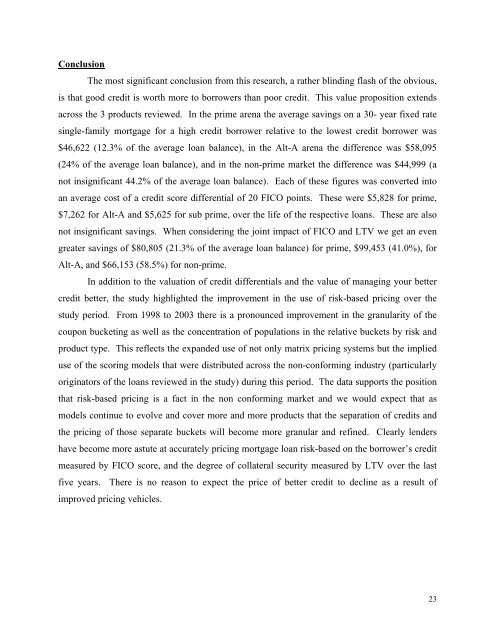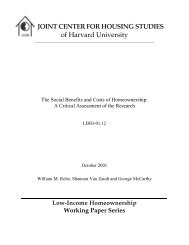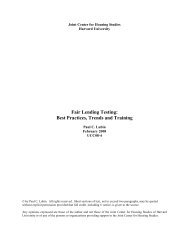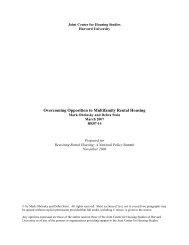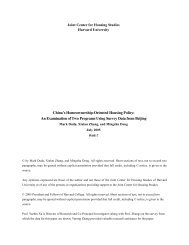Untitled - Joint Center for Housing Studies - Harvard University
Untitled - Joint Center for Housing Studies - Harvard University
Untitled - Joint Center for Housing Studies - Harvard University
You also want an ePaper? Increase the reach of your titles
YUMPU automatically turns print PDFs into web optimized ePapers that Google loves.
Conclusion<br />
The most significant conclusion from this research, a rather blinding flash of the obvious,<br />
is that good credit is worth more to borrowers than poor credit. This value proposition extends<br />
across the 3 products reviewed. In the prime arena the average savings on a 30- year fixed rate<br />
single-family mortgage <strong>for</strong> a high credit borrower relative to the lowest credit borrower was<br />
$46,622 (12.3% of the average loan balance), in the Alt-A arena the difference was $58,095<br />
(24% of the average loan balance), and in the non-prime market the difference was $44,999 (a<br />
not insignificant 44.2% of the average loan balance). Each of these figures was converted into<br />
an average cost of a credit score differential of 20 FICO points. These were $5,828 <strong>for</strong> prime,<br />
$7,262 <strong>for</strong> Alt-A and $5,625 <strong>for</strong> sub prime, over the life of the respective loans. These are also<br />
not insignificant savings. When considering the joint impact of FICO and LTV we get an even<br />
greater savings of $80,805 (21.3% of the average loan balance) <strong>for</strong> prime, $99,453 (41.0%), <strong>for</strong><br />
Alt-A, and $66,153 (58.5%) <strong>for</strong> non-prime.<br />
In addition to the valuation of credit differentials and the value of managing your better<br />
credit better, the study highlighted the improvement in the use of risk-based pricing over the<br />
study period. From 1998 to 2003 there is a pronounced improvement in the granularity of the<br />
coupon bucketing as well as the concentration of populations in the relative buckets by risk and<br />
product type. This reflects the expanded use of not only matrix pricing systems but the implied<br />
use of the scoring models that were distributed across the non-con<strong>for</strong>ming industry (particularly<br />
originators of the loans reviewed in the study) during this period. The data supports the position<br />
that risk-based pricing is a fact in the non con<strong>for</strong>ming market and we would expect that as<br />
models continue to evolve and cover more and more products that the separation of credits and<br />
the pricing of those separate buckets will become more granular and refined. Clearly lenders<br />
have become more astute at accurately pricing mortgage loan risk-based on the borrower’s credit<br />
measured by FICO score, and the degree of collateral security measured by LTV over the last<br />
five years. There is no reason to expect the price of better credit to decline as a result of<br />
improved pricing vehicles.<br />
23


